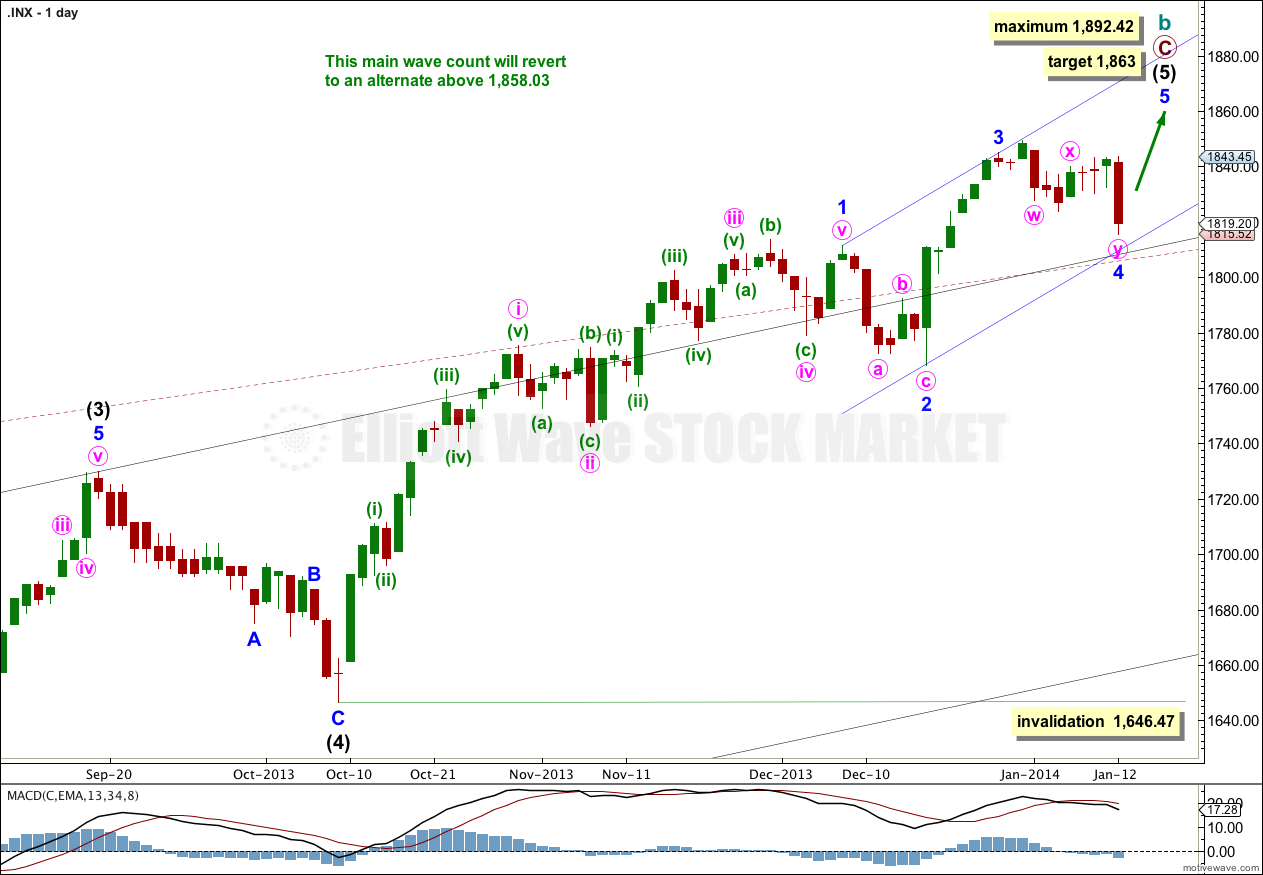Strong downwards movement was expected for the main hourly wave count, but slight upwards movement invalidated the labeling within it first and then downwards movement ended deeper than expected.
Overall the main hourly wave count is correct with a slight adjustment. At the daily chart level this wave count looks typical and has a good fit.
Click on the charts below to enlarge.
This wave count has a higher probability than the bullish alternate. Upwards movement over the last 4 years and 10 months subdivides best as a zigzag. If something is “off” about the supposed recovery then it must be a B wave because there is plenty that is off in this scenario in terms of social mood.
Minor waves 1, 2 and 3 are complete. Minor wave 4 is now most likely complete. There is almost no room left for it to move because it may not move into minor wave 1 price territory below 1,813.55 (please note: prior analysis stated this invalidation point incorrectly).
We may be about to see a larger fractal at minor wave degree of the structure within minor wave 1 at minute wave degree; there the first wave was extended, the third wave was shorter, and the fifth wave was shorter still.
Intermediate wave (3) is just 0.76 points short of 2.618 the length of intermediate wave (1). We may not see a Fibonacci ratio between intermediate wave (5) and either of (3) or (1).
At this stage I am not expecting intermediate wave (5) to exhibit a Fibonacci time relationship.
At super cycle degree the structure is an expanded flat correction. Within the flat the maximum common length of cycle wave b is 138% the length of cycle wave a, and this is achieved at 1,858.03. When cycle wave b is longer than the common length of cycle wave a then the probability that an expanded flat is unfolding would reduce and it would be more likely that a long term bull market is underway. Above 1,858.03 I will swap this main wave count over with the bullish alternate.
It is extremely likely now that minor wave 4 is over and lasted 10 days. Within minor wave 4 the structure still subdivides best as a double flat correction, although it has an atypical look in that it slopes more downwards than moves sideways. However, this is how the subdivisions fit.
Because of the depth and duration of this correction it is extremely likely to be over there. If minuette wave (c) within the second flat of the double moves any lower it has almost no room left to move into, and on the five minute chart the structure for this C wave is complete.
I would expect now to see about five to eight days of upwards movement towards the target. At 1,863 minor wave 5 would reach 0.618 the length of minor wave 3.
Within intermediate wave (5) the third wave of minor wave 3 may not be the shortest. This limits minor wave 5 to no longer than equality with minor wave 3 at 1,892.42.
When minute waves i, ii, iii and iv within minor wave 5 are complete then I will add to the target calculation at minute wave degree, so it may widen to a small zone or it may change.
If minuette wave (c) moves any lower tomorrow it may not move below 1,813.55. Minor wave 4 may not move into minor wave 1 price territory.
Bullish Alternate Wave Count.
It is possible that a new cycle degree bull market began at 666.79. So far it is not yet halfway through, and I would expect it to last for a few years (at least five more years and probably longer).
The current upwards impulse, labeled intermediate wave (5) for the main wave count and minor wave 5 for this alternate is incomplete. The structure within the final fifth wave is the same, and the structure on the hourly chart is the same. Targets would be the same for this bullish wave count. This wave count does not diverge with the main wave count, and it will not for several weeks or a couple of months or so yet.
The maroon – – – channel is an acceleration channel drawn about primary waves 1 and 2 on the monthly chart (it is drawn in exactly the same way on the main wave count, but there it is termed a corrective channel). I would not expect intermediate wave (2) to breach this channel because a lower degree (intermediate) wave should not breach an acceleration channel of a higher degree (primary) first and second wave.




